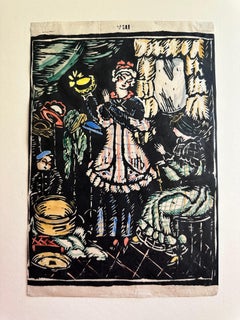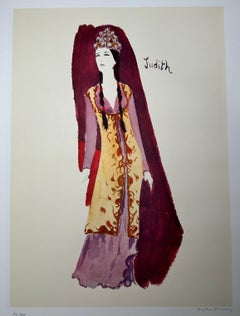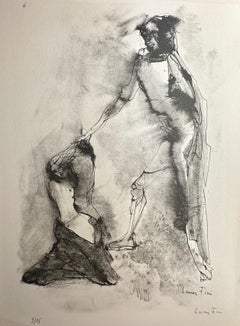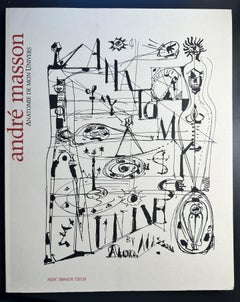Want more images or videos?
Request additional images or videos from the seller
1 of 8
Berthold LöfflerDie Sieben Zwerge Sneewittchens1911
1911
$10,000List Price
About the Item
- Creator:Berthold Löffler (1874 - 1960, Austrian)
- Creation Year:1911
- Dimensions:Height: 12.5 in (31.75 cm)Width: 10.25 in (26.04 cm)
- Medium:
- Movement & Style:
- Period:
- Condition:
- Gallery Location:Wilton, CT
- Reference Number:1stDibs: LU1362211420672
About the Seller
4.8
Vetted Professional Seller
Every seller passes strict standards for authenticity and reliability
Established in 2017
1stDibs seller since 2020
27 sales on 1stDibs
Authenticity Guarantee
In the unlikely event there’s an issue with an item’s authenticity, contact us within 1 year for a full refund. DetailsMoney-Back Guarantee
If your item is not as described, is damaged in transit, or does not arrive, contact us within 7 days for a full refund. Details24-Hour Cancellation
You have a 24-hour grace period in which to reconsider your purchase, with no questions asked.Vetted Professional Sellers
Our world-class sellers must adhere to strict standards for service and quality, maintaining the integrity of our listings.Price-Match Guarantee
If you find that a seller listed the same item for a lower price elsewhere, we’ll match it.Trusted Global Delivery
Our best-in-class carrier network provides specialized shipping options worldwide, including custom delivery.You May Also Like
Mädchen am Fenster. 1906-08.
By Oskar Kokoschka
Located in New York, NY
Mädchen am Fenster. 1906-08. Color lithograph printed on smooth card stock. Full margins. , signed by the artist in pencil, on the recto. Published by the Wiener Werkstätte, Vienna, with the printed postcard text on verso. Among Kokoschka's earliest prints were a series of 14 postcards, the current work and the following lot that he produced for the Wiener Werkstätte. Wingler/Welz 4.
Oskar Kokoschka was an Austrian artist, poet and playwright best known for his intense expressionistic portraits...
Category
Early 1900s Vienna Secession Figurative Prints
Materials
Lithograph
Der Polster
By Max Kurzweil
Located in New York, NY
Kurzweil, Maximilian. Der Polster, 1903. Color woodcut on japon. Included as an insert in Pan. Unsigned. Framed.11 1/4 x 10 1/4. 1
Ref: Hofstatter, p. 241; Pabst, p. 154.
Maximillian Kurzweil was the co-founder of the Vienna Secession in 1897 and editor and illustrator of the influential Secessionist magazine Ver Sacrum...
Category
Early 1900s Vienna Secession Figurative Prints
Materials
Lithograph
Gerlach's Allegorien Plate #116: "Force, Thirst, Love" Lithograph
By Carl Otto Czeschka
Located in Chicago, IL
after Carl Otto Czeschka, (1878-1960), Austrian
A leading member of the Vienna Secession and later the Wiener Werkstätte (Viennese Workshop), Carl Otto Czeschka was a vital figu...
Category
1890s Vienna Secession Figurative Prints
Materials
Lithograph
$900
H 17.25 in W 13.75 in
Gerlach's Allegorien Plate #78: "Hunting" Lithograph by Carl Otto Czeschka
By Carl Otto Czeschka
Located in Chicago, IL
after Carl Otto Czeschka, (1878-1960), Austrian
A leading member of the Vienna Secession and later the Wiener Werkstätte (Viennese Workshop), Carl Otto Czeschka was a vital figu...
Category
1890s Vienna Secession Figurative Prints
Materials
Lithograph
$2,250
H 17.25 in W 13.75 in
Ottokar Mascha Folio: plate 11 "5th Secession Exhibition Poster" by Kolo Moser
By Koloman Moser
Located in Chicago, IL
after KOLOMAN MOSER (1868-1918) 5TH SECESSION EXHIBITION POSTER, 1899, (In Mascha, no. 11) A pivotal figure in early-20th century Austrian ...
Category
1910s Vienna Secession Figurative Prints
Materials
Lithograph
$6,200
H 15.25 in W 11.5 in
Gerlach's Allegorien Plate #78: "Dance & Wine" Lithograph by Carl Otto Czeschka
By Carl Otto Czeschka
Located in Chicago, IL
after Carl Otto Czeschka, (1878-1960), Austrian
A leading member of the Vienna Secession and later the Wiener Werkstätte (Viennese Workshop), Carl Otto Czeschka was a vital figu...
Category
1890s Vienna Secession Figurative Prints
Materials
Lithograph
Gerlach's Allegorien Plate #114: "Vignettes" Lithograph by Carl Otto Czeschka
By Carl Otto Czeschka
Located in Chicago, IL
after Carl Otto Czeschka, (1878-1960), Austrian
A leading member of the Vienna Secession and later the Wiener Werkstätte (Viennese Workshop), Carl Otto Czeschka was a vital figu...
Category
1890s Vienna Secession Figurative Prints
Materials
Lithograph
Gerlach's Allegorien Plate #98: "Poetry" Lithograph by Carl Otto Czeschka
By Carl Otto Czeschka
Located in Chicago, IL
after Carl Otto Czeschka, (1878-1960), Austrian
A leading member of the Vienna Secession and later the Wiener Werkstätte (Viennese Workshop), Carl Otto Czeschka was a vital figu...
Category
1890s Vienna Secession Figurative Prints
Materials
Lithograph
$900
H 13.75 in W 17.25 in
Gerlach's Allegorien Folio, plate #58: "Sculpture" Lithograph, Gustav Klimt.
By Gustav Klimt
Located in Chicago, IL
As an artist trained in the applied arts, Gustav Klimt valued all forms of art, including the graphic arts. This final design from 1896 for inclusion in Allegorien published by Gerlach & Schenk demonstrates respect for artistic precedent and for a wide range of media and technique. The publication was printed in an unknown number of copies. Klimt’s rendering in latin of the title, “SCVLPTVR.,” with three-dimensional effect on the wall, is a figurative allusion to this medium as well as a literal reference to Ancient Rome. By doing the same with his signature and date in roman numerals on the right hand side of the image, Klimt places himself, The Artist, firmly in this linear and legitimizing context of art history and as its modern standard-bearer. Playing on Classical mythology and the story of Pygmalion, in which a statue comes to life, Klimt presents his modern Venus holding an apple. Klimt’s Venus exhibits a curvilinear softness; there are no angles. Klimt deftly shows the possibilities in a graphic image to give life to dark, wavy hair and tenderness to swelling breasts and belly. To further emphasize the allegory of thriving modern art, he contrasts his Venus with the cold, hard ancient classical head whose eyes are vacuous and whose hair is but a stylized mass of curls. Klimt’s living Venus stands in front of the large bust and large classical pillar upon which is a sculpture of a Sphinx and a Greek Attic bust. As if a gallery to represent sculpture’s “best of” through the ages, the upper horizontal panel includes bust depictions in marble, cast metal and wood...
Category
1890s Vienna Secession Figurative Prints
Materials
Lithograph
$13,500
H 17.25 in W 13.75 in
Gerlach's Allegorien Plate #93: "Science" Lithograph by Carl Otto Czeschka
By Carl Otto Czeschka
Located in Chicago, IL
after Carl Otto Czeschka, (1878-1960), Austrian
A leading member of the Vienna Secession and later the Wiener Werkstätte (Viennese Workshop), Carl Otto Czeschka was a vital figu...
Category
1890s Vienna Secession Figurative Prints
Materials
Lithograph
$3,200
H 17.25 in W 13.25 in
More From This Seller
View AllUntitled Woodcut
Located in Wilton, CT
Original hand-colored woodcut from a portfolio of Secessionist fashion illustrations. Signed in the lower right margin by the artist, Reni Schaschl (1895-1979), a talented member of...
Category
1910s Vienna Secession Figurative Prints
Materials
Woodcut
$2,800 Sale Price
20% Off
Judith
By Dorothea Tanning
Located in Wilton, CT
12 large scale lithographs, signed and numbered,by Dorthea Tanning. Costume designs for the opera Judith.
Category
1970s Other Art Style Figurative Prints
Materials
Lithograph
$2,000 Sale Price
20% Off
Histiore d'O
By Leonor Fini
Located in Wilton, CT
Print from the Fini book Histoire d'O, signed in pencil and numbered 9/15
Category
1960s Surrealist Figurative Prints
Materials
Lithograph
$1,200 Sale Price
20% Off
Anatomie de Mon Univers
By André Masson
Located in Wilton, CT
Reprint of Andre Masson's book from 1939. Printed on heavy wove paper. 30 plates of black and white drawings.
Category
1930s Surrealist Figurative Prints
Materials
Lithograph
$408 Sale Price
20% Off
Les Bars, selected prints
By Almery Lobel-Riche
Located in Wilton, CT
6 plates from the Lobel- Riche books, Les Bars depicting pre- war Paris fashions in the bars and nightclubs.
Category
1910s Art Nouveau Figurative Prints
Materials
Etching
$480 Sale Price
20% Off
Pensees sur la Danse
By Aristide Maillol
Located in Wilton, CT
number 411/720. 7 full page figurative drawings illustrating Serge Lifar's text.
Category
1940s Figurative Prints
Materials
Paper
Recently Viewed
View AllMore Ways To Browse
Joseph And His Brothers
Kaws Pink Companion
Keith Haring Bill T Jones
Laura Owens
Le Couple
Leonard Baskin Woodcut
Les Bijoux Vintage
Linocut Africa
Lithograph Jesus
Lois Jones
Marc Chagall Lion
Matisse Exhibition Poster
Native American Indian Prints
Norman Rockwell Signed Lithographs
Pablo Picasso Women
Pere Ubu
Peter Max Angel
Picasso 1964



